In the 1820’s, people began to realize there was something peculiar about some of the fossilized bones, teeth, and claws they were digging up from the earth. There was nothing particularly new about the discoveries themselves. After all, people had been finding these fossils for thousands of years. Most often, they were mistaken for the remains of other large lifeforms, like giants1 or even dragons.2 But it was only in the 1820’s that we came to see them as more than mere scientific curiosities. By 1843, Sir Richard Owen decided he would classify the several, large reptilian creatures as one group. He named that group “Dinosauria,” which means “terrible lizards.”
The views expressed in this article reflect those of the author and not necessarily those of New Creation.
Paleontologists (scientists who study fossils) have identified more than a thousand different species so far.3 They find fossils all over the world, including Antarctica. It is not just dinosaur bones that we find, but also their teeth, claws, and sometimes even skin and internal organs.4 Aside from dinosaurs themselves, we also find their skin impressions, nests and eggs (sometimes containing embryos!), footprints, droppings, and burrows. We have learned much since the early days of dinosaur research. We have a pretty good idea what they looked like, what they ate, how they moved, their habitat preferences, and even how they raised their young.
But most paleontologists think dinosaurs existed many millions of years ago. As young-earth creationists, we think that life on earth has only existed for the past several thousand years. How do we reconcile what we know from Scripture with humanity’s newfound knowledge about dinosaurs?
The Dino Basics
What is a Dinosaur?
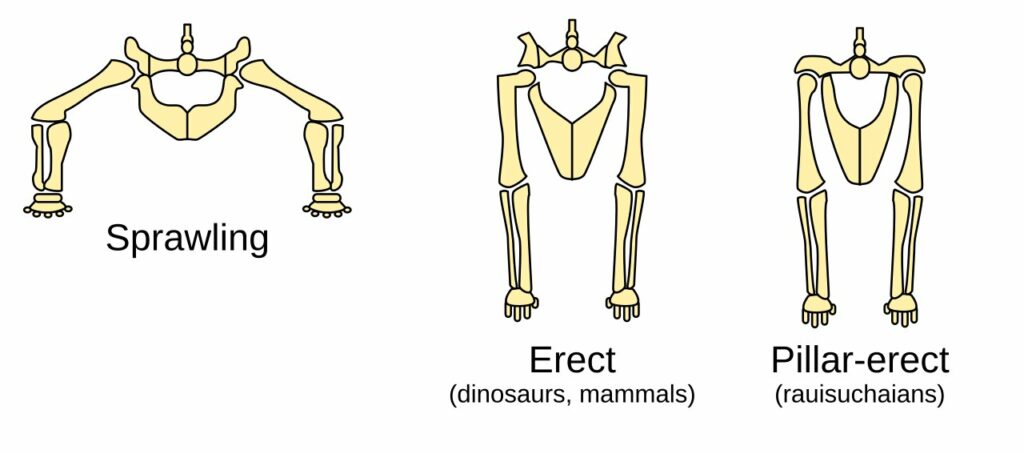
Many people associate the word “dinosaur” with any large, scaly, lizard-looking thing from yesteryear. This confusion probably stems from the meaning of the word in Greek, which, as you will recall, is “terrible lizard.” In reality, dinosaurs are not lizards. They belong to a diverse group of reptiles called archosaurs, which also contains crocodiles and alligators. There are a number of traits scientists use to distinguish dinosaurs from non-dinosaur archosaurs.
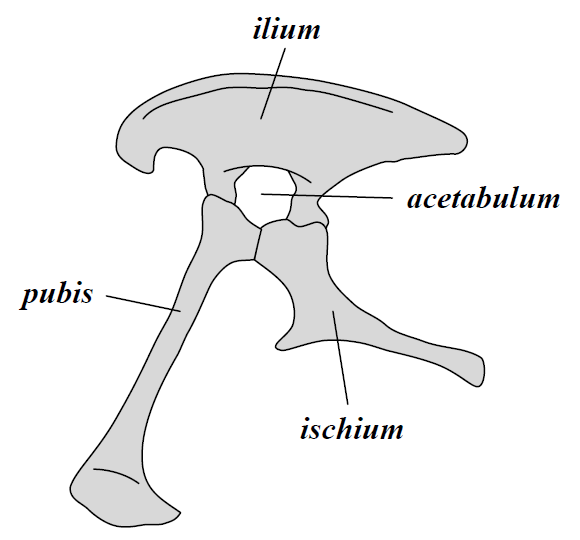
A hole in their hip socket, called the perforated acetabulum, is one of the most distinctive traits. Lizards, alligators, and crocodiles do not have this feature. Neither do pterosaurs (“pterodactyls”) or marine reptiles. This means they are also to be excluded from the dinosaur group.
Another important distinction between modern reptiles, like lizards and crocodiles, from dinosaurs is their stance. Modern reptiles walk with their legs sprawled out to the sides. Their tails often drag on the ground behind them. Dinosaurs, however, carried their bodies directly above their legs, much like mammals do. This enabled them to live a much more active lifestyle.
What Did Dinosaurs Look Like?
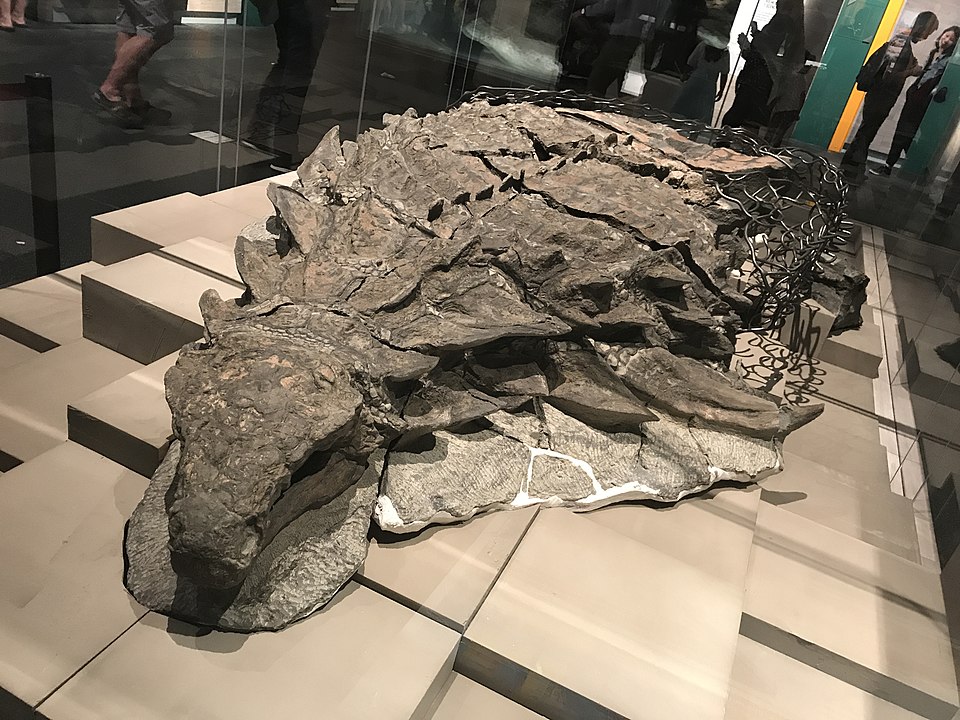
Given that over 1,000 species exist within the group, there is no such thing as a “generic dinosaur.” They came in all shapes and sizes. The largest known dinosaurs, the long-necked sauropods like Supersaurus, measured up to 112 feet from nose to tail. Meanwhile the 3.9-ounce Anchiornis was one of the smallest dinosaurs, about the size of a pigeon. Some dinosaurs exhibited an assortment of plates (Stegosaurus), spikes (Borealopelta), horns (Carnotaurus), crests (Citipati), and frills (Achelousaurus). Struthiomimus and others like it possessed nimbleness and speed, while Saichania favors the heavily-armored tank kind of build. There were even dinosaurs, like Yi qi, that could take to the air by gliding from tree to tree. Others spent much of their time in the water, like Halszkaraptor.
Much of what we know about the dinosaurs’ appearance in life is from well-preserved fossils. These fossils preserved external features, like their skin and body covering. Discoveries of skin impressions, and even the skin itself, show that many dinosaurs had scales, not unlike those you might see on the foot of a chicken, parrot, or emu. Studies of the microscopic cells in their skin reveal that at least some had color patterns. Modern animals use similar color patterns for camouflage in forested habitats.
Did Any Dinosaurs Have Feathers?
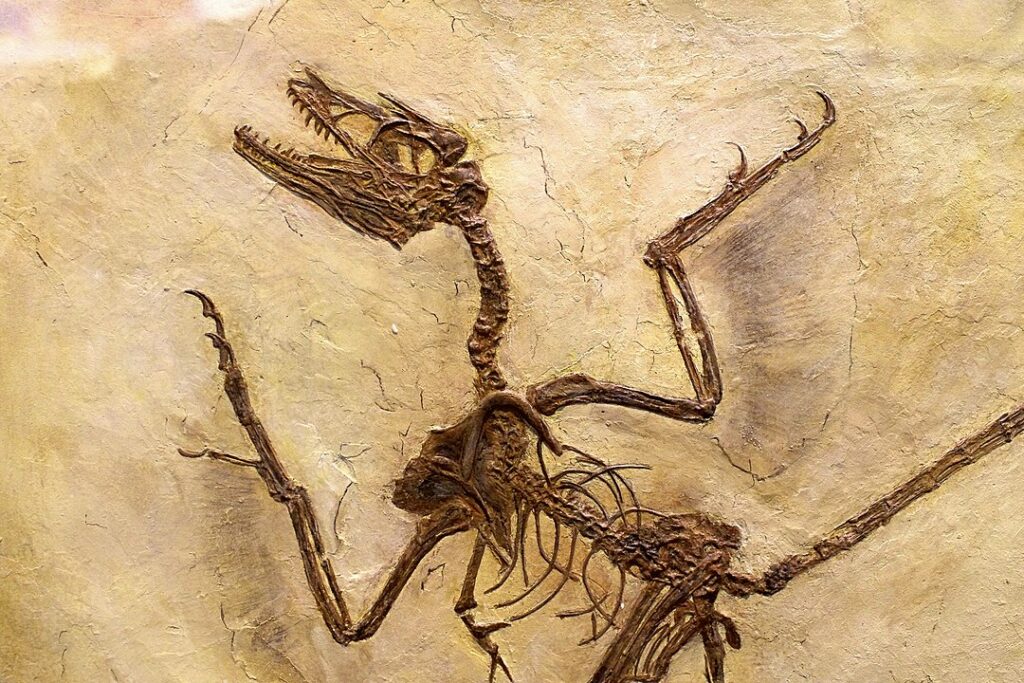
We have good reason to think God originally filled His world with a greater variety of feathered creatures than exists today. Some were very much like modern birds, others less so. Regardless, all of these creatures have a perforated acetabulum. This indicates quite strongly that, yes, some dinosaurs really did have feathers!
Not all feathered dinosaurs had the same types of feathers. Psittacosaurus (a two-legged Triceratops-like dinosaur without the horns and frill) was an otherwise scaly dinosaur with long, quill-like structures along the base of its tail. The small theropod (meat-eating dinosaur) Sinosauropteryx possessed a covering of fuzzy filaments much like the down that covers baby birds. These probably helped keep the animal warm in cooler temperatures. Quill knobs found along the arm bones of Velociraptor itself indicate these creatures had wings in life. These dinosaurs could not fly, but perhaps used their wings for balance or for showing off. Ostriches are also flightless and use their wings in very much the same way. Research even suggests that many animals we typically think of as birds, such as Archaeopteryx, were not actually true birds. We might more accurately describe them as feathered dinosaurs.5
The feathers of the dinosaur Caihong, studies show, were iridescent, giving off a colorful, rainbow-like sheen when exposed to sunlight.6 Hummingbird feathers exhibit a similar effect today.
How Did Dinosaurs Live?
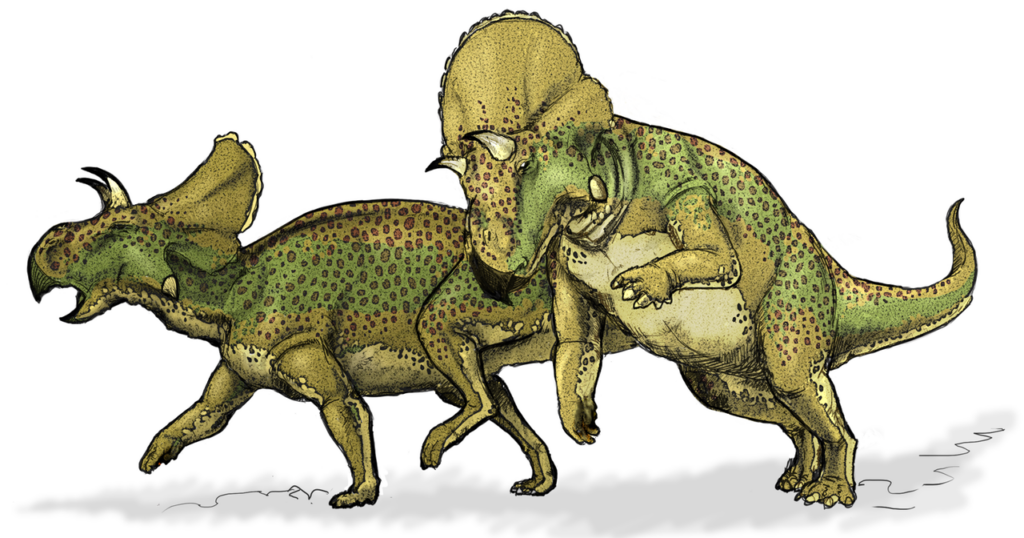
Throughout most of the 19th and 20th centuries, we envisioned dinosaurs as sluggish, cold-blooded, overgrown lizards. Because of their humongous size, researchers thought many of them needed to wallow in swamps just to support their body weight. But paleontology (the study of fossils) has undergone a revolution in its understanding of dinosaurs since the 60’s. This dinosaur revolution continues today.
Evidence suggests these animals lived active and energetic lifestyles, more like mammals and birds than modern reptiles.7 Discoveries of hundreds or thousands of the same dinosaur species buried in the same place suggests that many lived in large groups. The evidence of such diverse physical design supports this. Their diverse crests, frills, horns, and other display ornaments suggest they had complex social behaviors.
Recent fossil discoveries indicate that at least some dinosaurs cared for their eggs and hatchlings. Some specimens of Citipati died in the act of brooding over their nests of eggs, like birds do today. Paleontologists discovered their fossils with feathered arms positioned in a protective way, perhaps shielding their eggs from the elements.
The Real Age of the Dinosaurs
Old-earth paleontologists think dinosaurs existed millions of years ago. They also believe different dinosaur species lived at different times. They suggest the earliest dinosaurs appeared some 230 million years ago, while the last dinosaurs died out 66 million years ago. But where do dinosaurs fit on the young-earth timescale?
Biblical Evidence
Genesis 1 records the supernatural creation of all land animals on Day 6, the same day God created the first humans, Adam and Eve. As land animals, this also includes the creation of dinosaurs. From counting the years given in the genealogies of the Bible, especially Genesis 5 and 11, we can deduce this was only a few thousand years ago.
OK, But Are Dinosaurs Specifically Mentioned in the Bible?
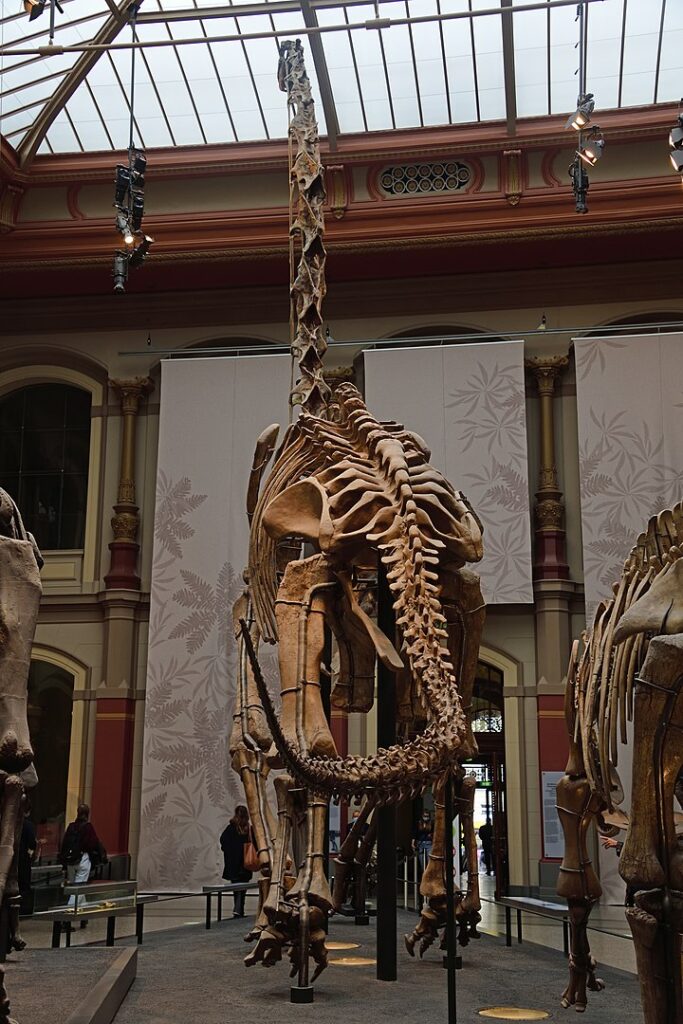
The Bible is a historical account, not a textbook on natural history. As such, it does not have much to say in the way of specific mentions of dinosaurs. This should not be surprising. There is a great deal the Bible does not talk about. It also makes no mention of the pyramids or the Great Wall of China. Neither are certain animals like house cats or ducks given mention.
Many creationists suggest that behemoth and leviathan, two creatures mentioned in the Book of Job, are actually dinosaurs. The challenge is that the Bible simply does not give us many specific details as to the physical appearance of either animal. This being the case, it is impossible for us to identify them with certainty.
One argument in favor of behemoth’s identification as a dinosaur regards its tail. The Bible describes it as swaying like a cedar tree. No other known animal possesses a tail capable of such a feat. Dinosaurs held their tails aloft, and the musculature of their hips caused their tails to sway back and forth with each step.8 Leviathan’s description is even more generic. We cannot say that it was a dinosaur anymore than we can say it was simply a very large crocodile. (Some extinct varieties, like Sarcosuchus, could grow well over 40 feet long!) For the time being, we should not be dogmatic as to the identification of either behemoth or leviathan.
Scientific Evidence

Despite the well-known “fact” that dinosaurs existed tens, or even hundreds, of millions of years ago, we must take note of the increasing number of dinosaur fossils found to contain original organic material (“soft tissue”) inside them. These include blood cells and vessels,9 proteins10,11 such as collagen,12 bone cells and bone tissue,13 nerves,14 and possibly even genetic material.15,16 All of these biological remnants should be long gone within thousands of years at the most.17 These finds are much more consistent with a young-earth timescale.
Do We Have Evidence That Humans Lived with Dinosaurs?
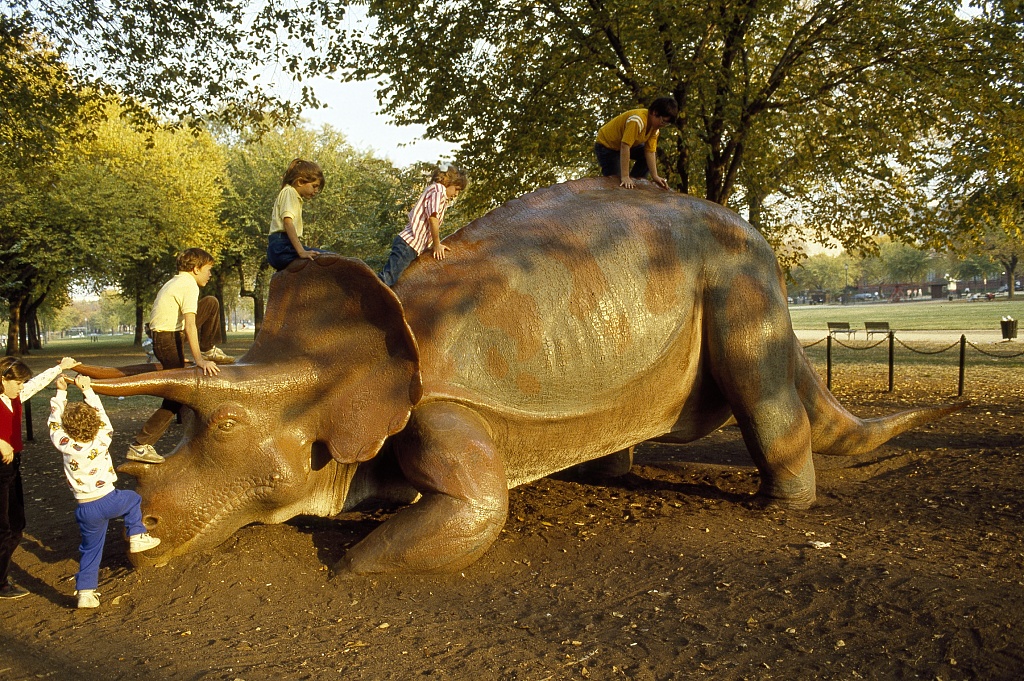
As described above, original organic material serves as scientific evidence that dinosaurs lived just thousands of years ago. This is very consistent with Scripture, which suggests that dinosaurs and humans lived at the same time. After all, God created both on Day 6. But does this also mean that the two coexisted? Are The Flintstones, The Good Dinosaur, and One Million Years B.C. on to something?
In the Garden of Eden, God tasked Adam with naming every kind of beast of the field. This may have included at least some varieties of dinosaurs. In addition, God brought two of every kind of air-breathing land animal to the Ark so that Noah’s family could care for them during the Flood. This certainly would have included dinosaurs.
Aside from these instances, however, there does not appear to be much physical evidence that humans and dinosaurs interacted on a regular basis. Archaeologists have never unearthed dinosaurs at their dig sites. Alleged findings of dinosaur and human fossils together, meanwhile, remain unsubstantiated at the present time.
Nevertheless, there are legends and depictions of dinosaur-like creatures from ancient cultures all over the world. Many creationists have suggested that these are evidence that humans interacted with dinosaurs up into the Middle Ages. Though given that we do not find any physical evidence of dinosaurs this late in history, we should hold this position with caution. Some instances of dinosaur-looking artifacts are questionable at best. And many of the legends and depictions may simply be from people’s imaginations or portray mythical beasts. Another possible source are cultural memories passed down from people who encountered dinosaurs before or shortly after the Flood, similar to the suggestion regarding flood legends around the world.18
Would We WANT To Live With Dinosaurs?
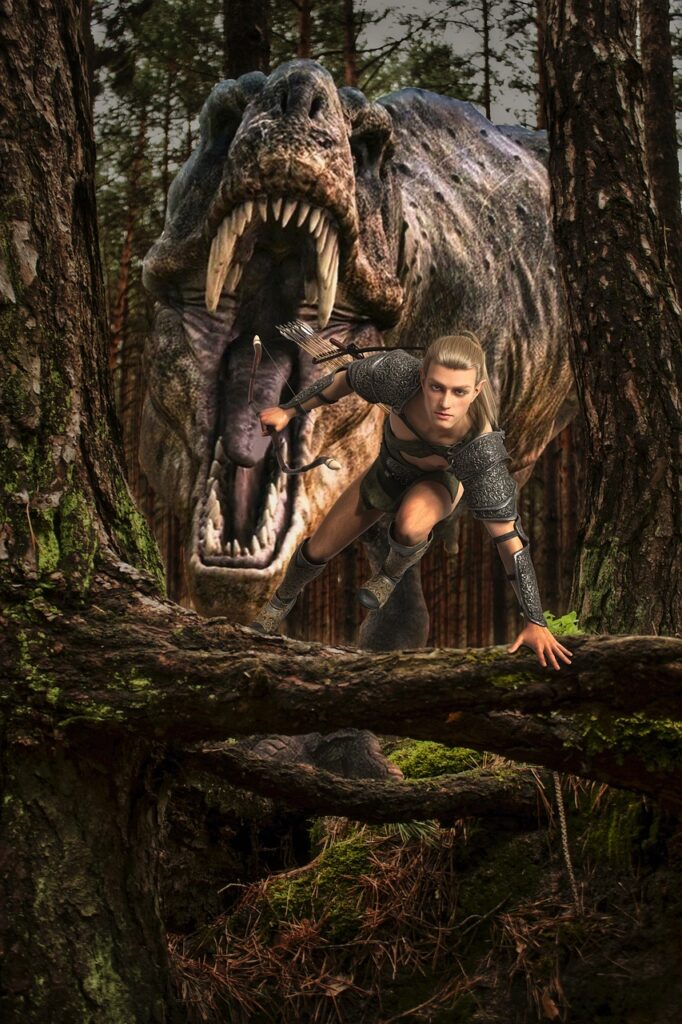
We must also consider whether humans would even want to live alongside dinosaurs. The predatory habits of many dinosaurs would certainly cause concern for any human deciding to live alongside them. But even moreso, the types of habitats dinosaurs seem to have preferred do not seem particularly conducive to complex human societies. The plants dominating most dinosaur-ruled habitats are non-flowering plants, like ferns, cycads, and conifers.
However, nearly all of the foods we consume (with the exception of things like pine nuts and fiddlehead ferns) are flowering plants (angiosperms), or are animals that eat flowering plants. While researchers have found flowering plants alongside dinosaurs, these plants are a relatively minor component of the ecosystem, and their seeds tend to be quite small.19 The fossil record demonstrates that abundant legumes, nuts, seeds, and fruits, as well as vegetables like asterids (lettuce, sunflowers, olives, carrots, potatoes, eggplants, tomatoes, peppers, and sweet potatoes), appear to have been largely absent from dinosaur habitats.20
Raising livestock to eat would also prove difficult in dinosaur-friendly habitats, as they too are also reliant on flowering plants. Fossil evidence of grasses (which include wheat, maize, and rice) do show up in dinosaur fossil deposits, but they are rare and have limited distribution. Meanwhile, grasslands required for grazing livestock are absent.21
These factors suggest it may have simply been safer and more efficient for humans to live in regions where the dinosaurs were not. If humans and dinosaurs did at one point live during the same time period, as we believe they did, we are unlikely to find evidence of them coexisting.
Are Dinosaurs Evidence for Evolution?
Where Did Dinosaurs Come From?
Old-earth paleontologists think that dinosaurs evolved from a common ancestor of both pterosaurs and crocodilians that lived more than 250 million years ago. If true, we should find a gradual increase in the diversity of dinosaur ancestor-like species as they evolve and diversify over time. Eventually, this would culminate in a great variety of true dinosaurs that are very different from each other.
In reality, however, the earliest rock layers of relevance contain a surprising diversity of dinosaurs.22 In fact, it is not just dinosaurs; most tetrapods (four-limbed land animals) that first show up in those same rock layers are very distinct from each other. But there are only a few varieties of each major group of these animals. These dinosaurs and other animals do not start out very similar and gradually become more and more different from each other as we ascend the rock layers. They are very distinct from the start.
From a biblical perspective, we would explain the origin of dinosaurs as part of the supernatural event of the sixth day of Creation Week.
How Many Kinds of Dinosaurs Are There?
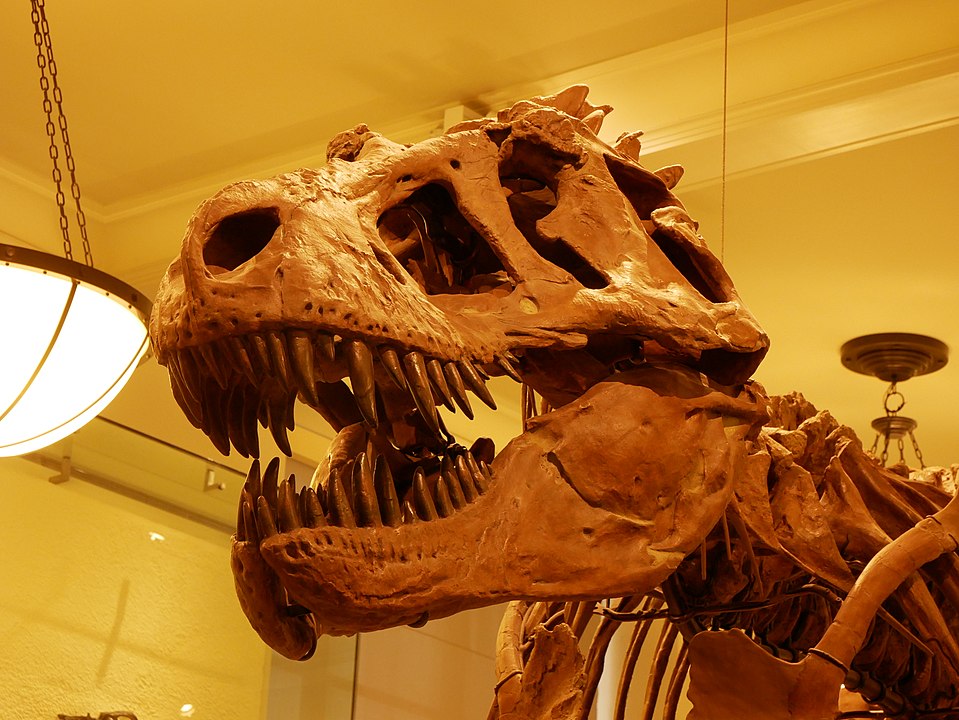
As mentioned before, we have discovered and named over 1,000 species of dinosaurs so far. But is this the number of species God originally created? Unlikely. Genesis 1 describes the creation of land animals according to distinct kinds. God created these kinds with the ability to change over time and diversify. As such, there can be many different varieties or species within a single created kind.
Baraminologists have carried out several statistical tests on various groups of dinosaurs. While research remains ongoing, they have identified some 20 tentative dinosaur kinds so far.23 Some notable examples include the stegosaur kind (e.g. Stegosaurus, Tuojiangosaurus, and Kentrosaurus), the pachycephalosaur kind (e.g. Pachycephalosaurus, Stegoceras, and Homalocephale), the tyrannosaur kind (e.g. Tyrannosaurus, Tarbosaurus, and Gorgosaurus), and the oviraptorosaur kind (e.g. Caudipteryx, Oviraptor, and Conchoraptor).
Created kinds identified in these studies usually fall around the family level of animal classification. If this bears out with future studies, there will likely be a total of 50 or 60 kinds of dinosaurs in all.
Did Birds Evolve from Dinosaurs?
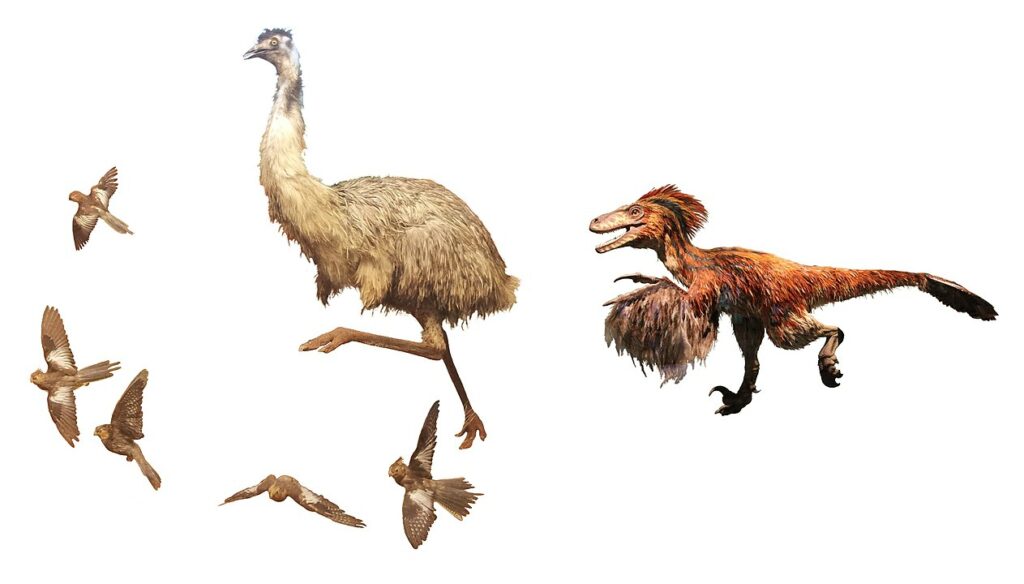
Many conventional paleontologists do not believe that all dinosaurs became extinct. Rather, they say that one very diverse group is still alive and well today: birds. They point out that birds and dinosaurs have many things in common. Like birds, dinosaurs lived active lifestyles and laid hard-shelled eggs (unlike other reptiles). Many even had feathers and three-toed feet. Most importantly, birds also have a perforated acetabulum, just like non-bird dinosaurs. For these reasons, it is possible for a young-earth paleontologist to classify birds as dinosaurs in the same way that we classify flying bats, swimming dolphins, or the egg-laying platypus as mammals.24 The mere fact that bats are mammals does not in any way rely on evolutionary thinking. As such, we could consider birds as a diverse sub-group within the larger dinosaur group, even within a young-earth paradigm.
Another problem is the claim that birds evolved from non-avian dinosaurs. Genesis states that God created various kinds of birds on Day 5 of Creation Week. Meanwhile, on Day 6, He created various kinds of land animals (including non-bird dinosaurs) , no more than a day/night cycle later.
Baraminologists applied the statistical tests described to birds and non-bird dinosaurs. They have found that there were many distinct kinds of birds and many distinct kinds of non-bird dinosaurs.25 They do not share a common evolutionary ancestor.
Witnesses To Catastrophe
Were Dinosaurs On Noah’s Ark?
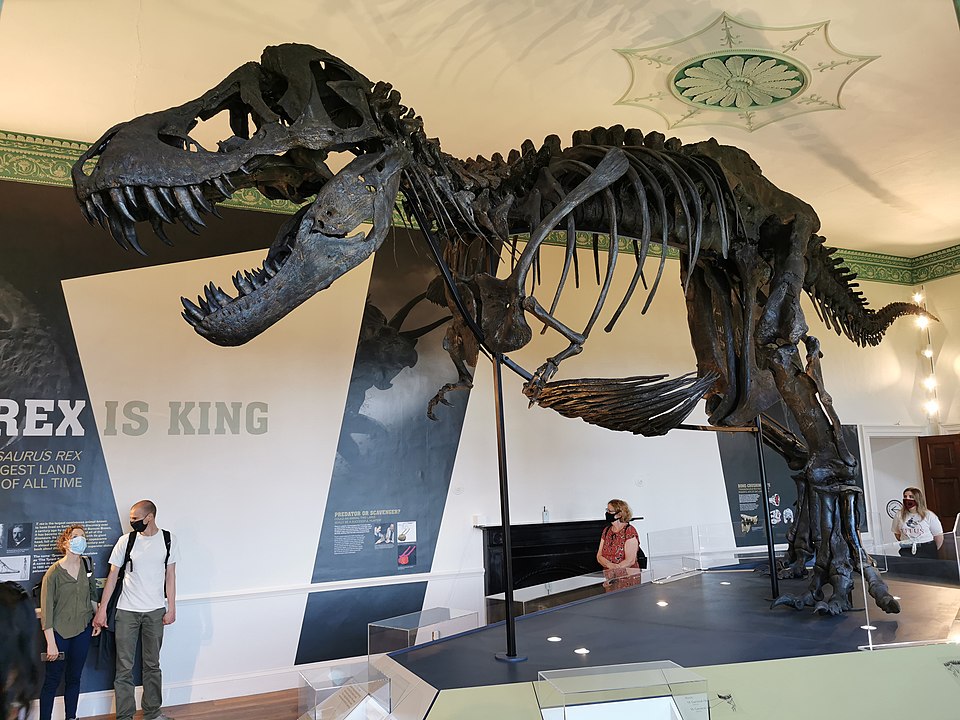
Since two of every kind of air-breathing land animal came to Noah in order to board the Ark (Genesis 6:20), dinosaurs would have almost certainly been among them. Figuring out how these creatures would have fit on the Ark has proven to be a head scratcher for some, especially when they take into consideration the immense size of some dinosaurs. However, we should remember that not all dinosaurs were giants. Some were the size of pigeons or sheep. The average dinosaur was about the size of an American bison, weighing about a ton. In addition, God did not instruct Noah to bring every species on the Ark, but every kind.
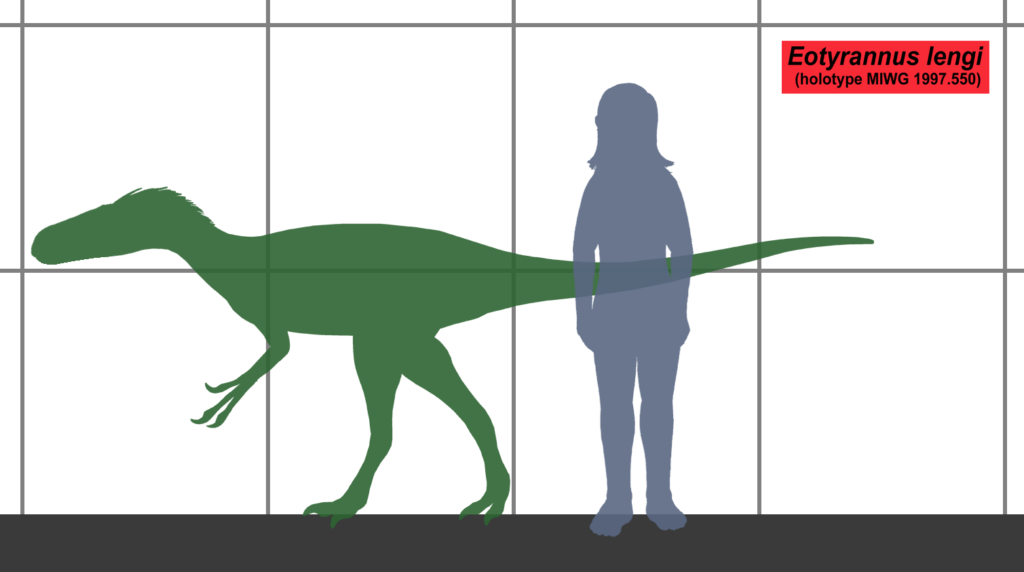
As such, Noah did not necessarily have to care for the enormous Supersaurus, an almost impossible task given the size of the vessel. God could have sent something like the much smaller Leinkupal, a close relative. Instead of Tyrannosaurus, God may have sent a dinosaur like Eotyrannus. These pocket-sized versions of their much larger relatives would have been easier to care for and would have taken up a lot less space on the Ark.
Are Dinosaur Fossils From Noah’s Flood?
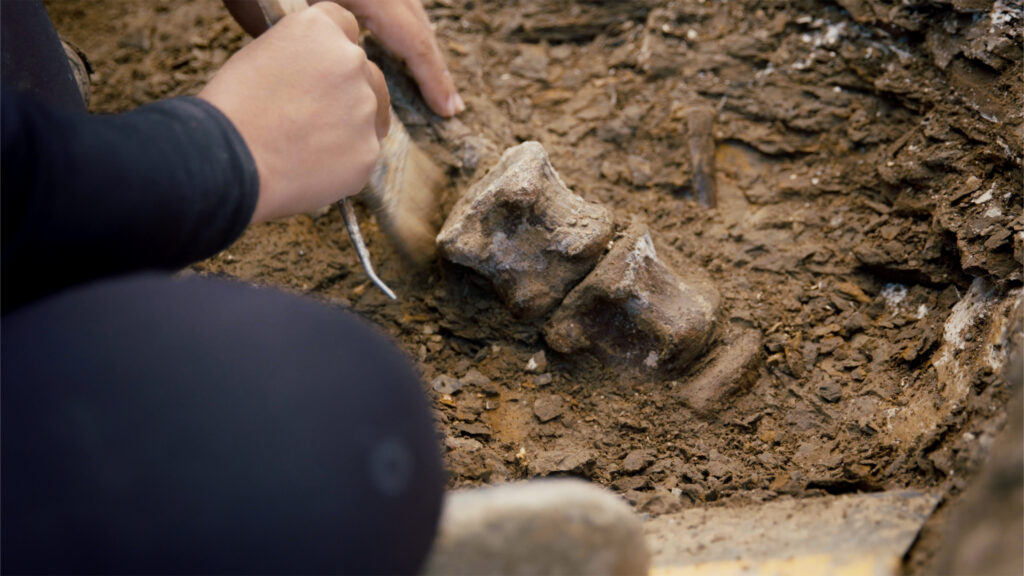
Dinosaur fossils are often found in thick packages of water-deposited sedimentary rock layers that are regional in scale. The Hell Creek Formation, Lance Formation, Scollard Formation, and Frenchman Formation, among several others, compose the Lancian formations of the western United States. They consist of assemblages of rock strata containing a treasure trove of dinosaur fossils.
The Hanson Ranch Bonebed in eastern Wyoming is one such fossil site. It contains the disassembled and jumbled up remains of somewhere between 10,000 and 25,000 dinosaurs, mostly of the duck-billed hadrosaur Edmontosaurus. A three- to six-foot thick layer of mudstone houses the fossils; larger bones —like femurs— are concentrated toward the bottom, and smaller bones —like vertebrae— are sorted toward the top. This means a single, watery, catastrophic event, probably an underwater debris flow, buried these fossils. Fossil sites like this lead most young-earth paleontologists to conclude that the fossilized dinosaurs we find resulted from the global Flood of Noah’s day.
Are Dinosaurs Still Around Today?
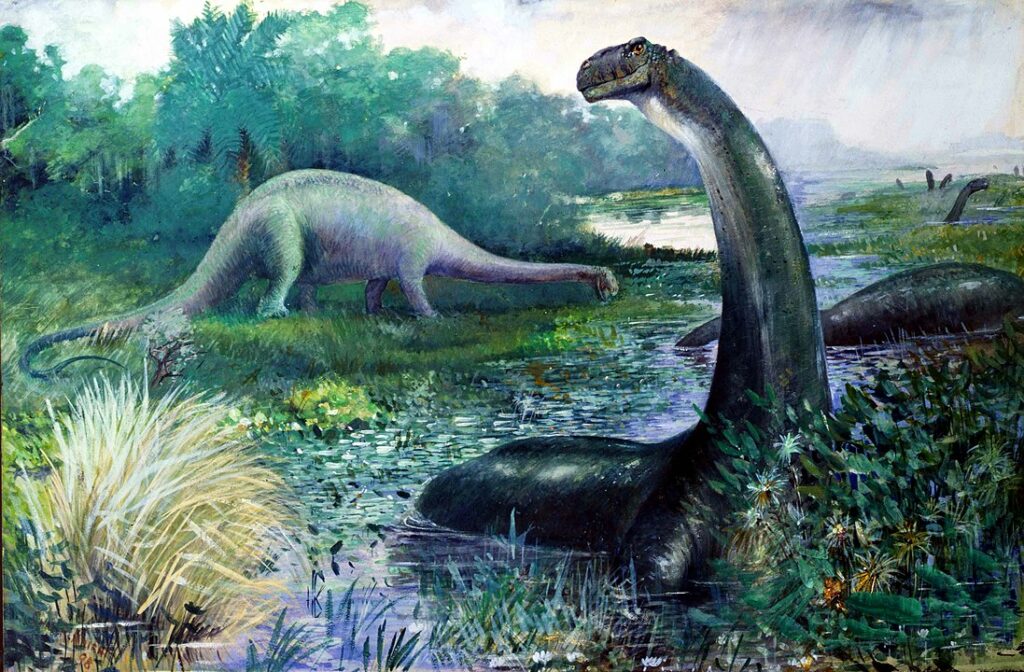
Through much of the late 20th century and early 2000’s, excited young-earth creationists hoped to discover a live dinosaur in some remote corner of the world. Perhaps the most popular example is mokele-mbembe, a sauropod-like creature claimed to dwell in the dense swamps of the African Congo.
Unfortunately, all quests to find the beast and others like it have turned up empty-handed. Even in the age of handheld smartphone cameras, satellites, and robust populations of humans around the globe, these alleged dinosaurs remain elusive.
As a result, most young-earth creationist organizations have abandoned the search for living dinosaurs. Instead, they put more emphasis on other fields relevant to creation science, like baraminology and paleontology.26
Areas of Further Research
Young-earth creationists have learned a lot in their quest to learn how dinosaurs fit within a biblical worldview. Even still, there are several puzzles that await solutions by the next generation of young-earth dinosaur researchers.
Where Did Pre-Flood Dinosaurs Live?
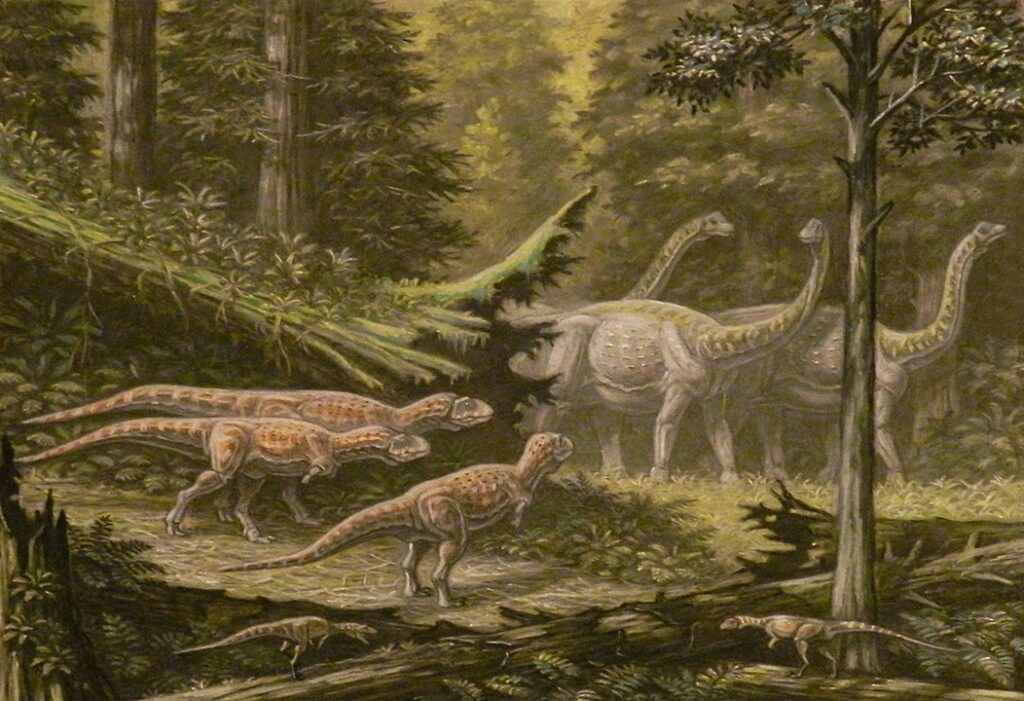
It is tempting to think dinosaurs lived wherever we find their fossils buried. This scenario proves problematic from a Flood perspective, however, because thick sequences of marine-deposited rock layers lie beneath those containing dinosaur fossils. If true, this scenario means those dinosaurs treaded water while the Flood deposited thousands of meters of sediment layers beneath them.
However, there exists considerable evidence that dinosaurs did not live where their fossils came to rest. Paleocurrents are geological features that scientists use to tell which direction the water was flowing when it deposited certain strata. By studying these features, we see evidence that dinosaurs and the sediment they are now buried in were transported considerable distances. But from where?
Geologist Tim Clarey suggests that dinosaurs may have lived in what were low-lying land areas before the Flood.27 He has dubbed one of these locations as the “Dinosaur Peninsula,” a broad strip of land stretching from what is now Minnesota to Arizona. As the floodwaters rose, he thinks dinosaurs were swept away from their original habitat locations and transported to their final resting places.
On the contrary, geologists Arthur Chadwick and Leonard Brand raise the possibility that at least some dinosaurs, as well as the other animals and plants preserved with them lived, on landmasses that were destroyed during the Flood. As these landmasses were being destroyed, they were transported from long distances away to where they are buried and found today.28
While hypotheses abound, data from the dinosaur-laden sedimentary layers speaks of long-distance transportation before arriving at their final resting place.
Dinosaur Trace Fossils and the Flood
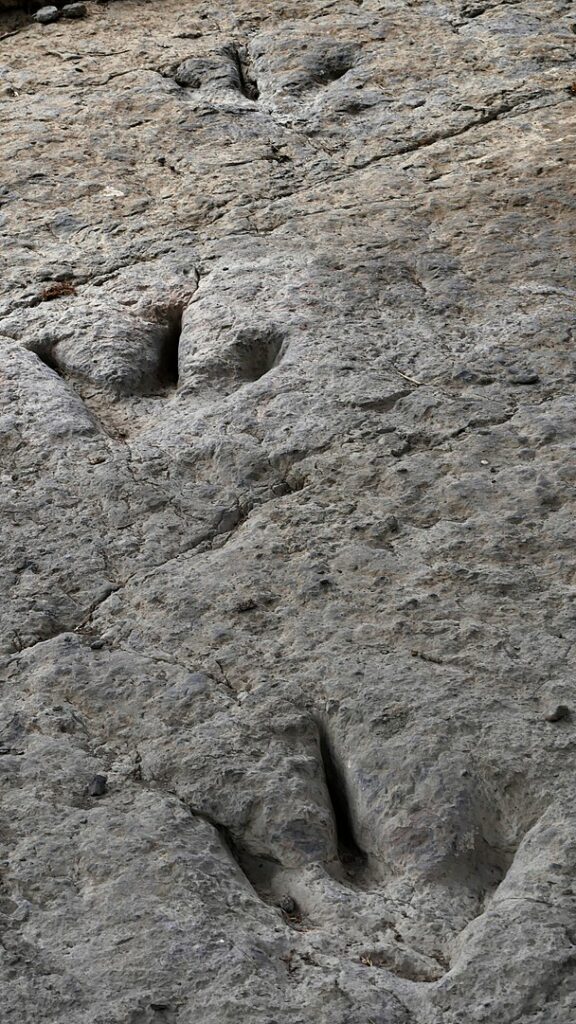
Trace fossils are the preserved traces left behind by animals. As far as dinosaurs are concerned, these include footprints, nests and eggs, gnaw marks and teeth embedded in the bones of other animals, droppings, and even burrows. How could dinosaurs produce any of these trace fossils during the global Flood?
We should take note that most trace fossils occur on extensive flat-lying sediment layers. Many young-earth scientists point out that even a small rise or fall in sea level (e.g. tides) or small movements of the earth’s tectonic plates could temporarily expose large areas of land for hours, days, weeks, or even months at a time before becoming submerged again.29,30,31 One proposition suggests these temporarily exposed surfaces set the stage for dinosaurs and other land animals to leave footprints, forage for food, lay eggs, and even burrow before another inundation of the floodwaters submerged the area.
More research on specific trace fossil sites can provide us with insight into the timing of these submergence and exposure episodes during the year-long Flood.
Gastroliths
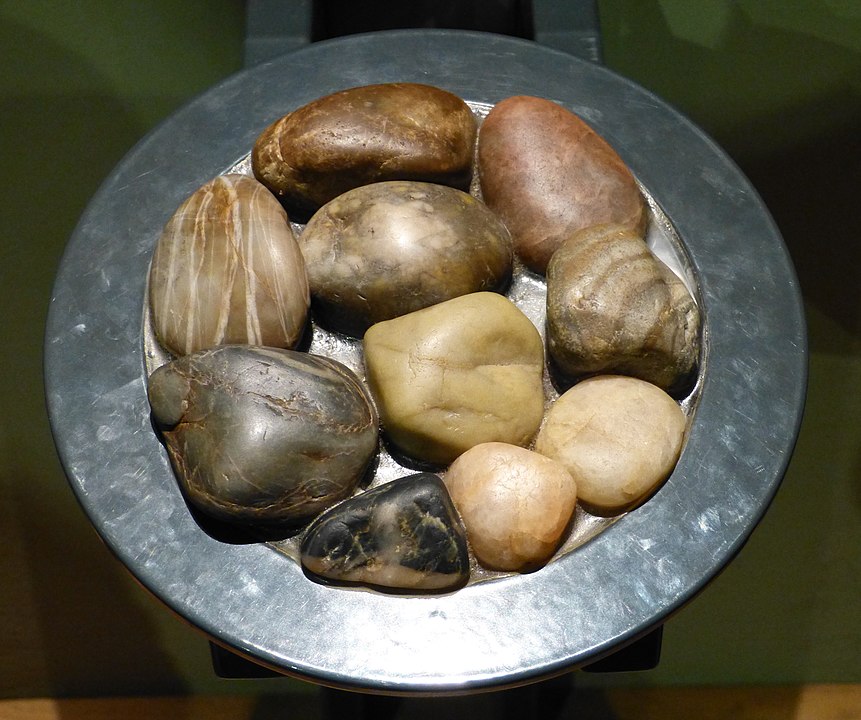
Gastroliths are a very unique kind of trace fossil. These are stones that some sauropods and several other types of dinosaurs swallowed in order to aid their digestion. Modern archosaurs (birds and crocodiles) exhibit this behavior today. Interestingly, some dinosaur gastroliths contain fossils that look like they came from other Flood deposits. Fossilized organisms contained within these gastroliths include sponges from the Kaibab Limestone and petrified wood from the Chinle Formation.32 Most young-earth geologists believe both of these formations formed during the Flood. This presents a unique challenge to our understanding of the Flood: how could dinosaurs swallow already hardened fragments of earlier Flood deposits?
It is important to remember that both old-earth and young-earth scientists are still making new discoveries in regard to how certain fossils and geologic features formed. Future research could show us how rocks and fossils could form earlier in the Flood year in ample time to be consumed by dinosaurs later in the Flood year. But for now, this remains a mystery in need of investigation.
Why Don’t We Find Fossils of Dinosaurs Mixed with “Modern” Types of Animals and Plants?
When we look at the Flood’s fossil record, we tend to find fossilized organisms buried alongside plants and animals they would have coexisted with as a distinct community. Dinosaurs are found buried alongside certain types of reptiles, birds, mammals, and plants. Most of these are either rare or virtually extinct today. Humans and more “modern” creatures like large mammals and most birds, and many flowering plants are absent. In fact, they do not appear to be preserved in the Flood’s fossil record at all.
We must remember that the fossil record is not a perfect snapshot of all biodiversity alive at any given time in earth history. Fossils require very special conditions in order to form. Because of this, there will alway sbe some parts of the world where fossil-friendly conditions occur, and places where fossils are unlikely to occur.
Young-earth paleontologists think that the world before the Flood consisted of distinct and segregated ecological zones or biomes, similar to how the world it today. They suggest that most dry land areas of the pre-Flood world were primarily home to dinosaur-dominated biomes. Based on their absence from the Flood’s fossil record, it appears that humans and modern animals and plants lived in a more densely populated biome that was not as widely distributed. As such, it may not have been preserved in a location favorable toward its fossilization.
Ongoing research hopes to determine exactly what these communities were like in the pre-Flood world, as well as how they were swept away, transported to, and buried in their final resting places.
How Did Dinosaurs Become Extinct?
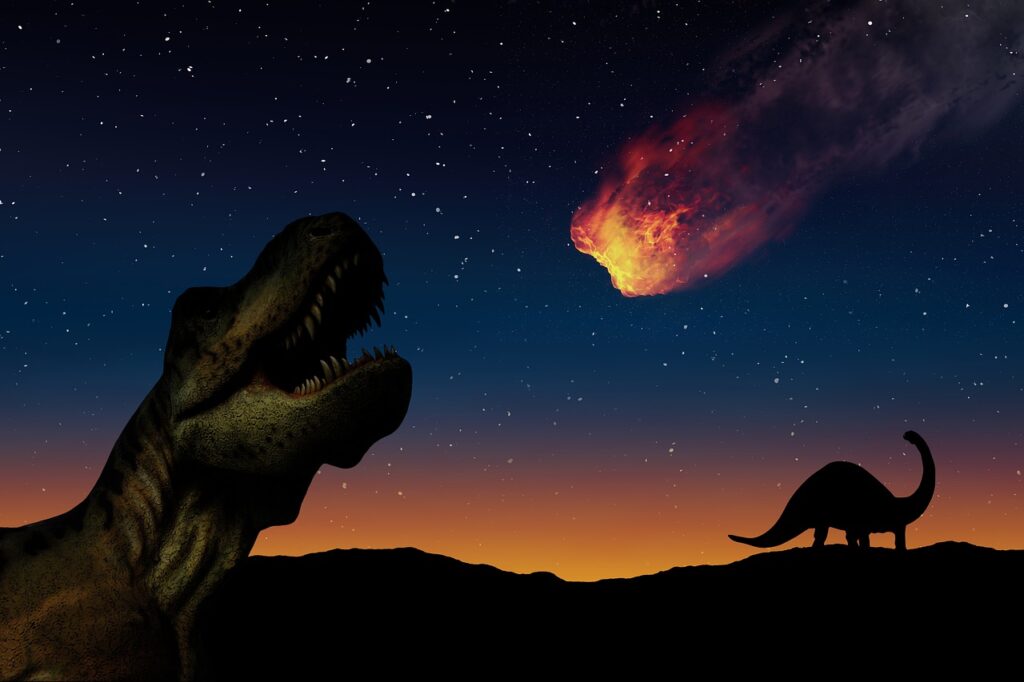
Most old-earth paleontologists are of the opinion that the non-avian dinosaurs became extinct when an asteroid hit the earth 66 million years ago. Rocky material, ash, and other debris rained down over the earth. The impact’s aftermath included massive tsunamis, earthquakes, wildfires, and a prolonged winter. Any dinosaurs that survived the initial blast died from starvation in the months or years that followed.
In contrast, most young-earth creationists think this asteroid hit during the Flood. If so, the Flood-surviving dinosaurs actually died out later, well after this asteroid impact occurred. Most young-earth paleontologists contend that there are no confirmed post-Flood dinosaur fossils.
More research in this area is needed. However, Dr. Kurt Wise suggests the extinction of the dinosaurs may have had something to do with the loss of their pre-Flood biome.33 Grasses, broad-leafed trees and other flowering plants are largely absent from fossil dinosaur communities. Instead, we commonly find these creatures alongside non-flowering plants like ferns, cycads, and conifers. Dr. Wise suggests that this is no coincidence. Gut contents and coprolites show that these were the types of plants herbivorous dinosaurs ate. They rarely consumed flowering plants. The non-flowering plants dinosaurs consumed largely went into decline after the Flood, and with them, the dinosaurs themselves may have as well.
Recolonization Theory
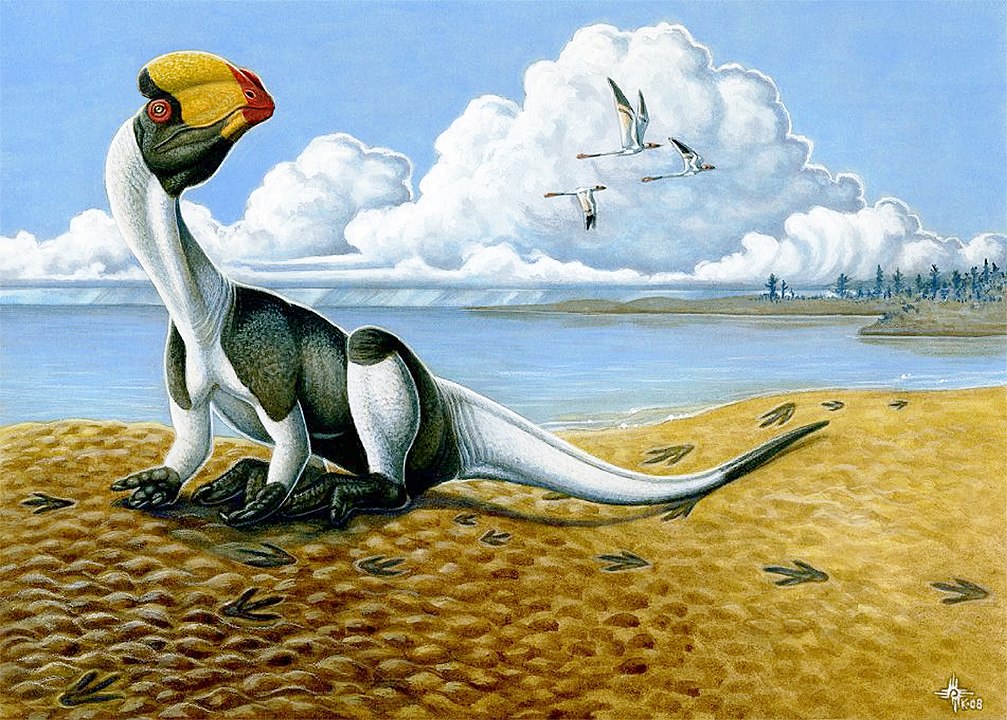
Not all young-earth creationists think the Flood buried the remains of dinosaurs. Those who adopt Recolonization Theory, called “recolonizers,” argue instead that these fossils are the descendants of the dinosaurs that came off the Ark, multiplied, and spread throughout the world after the Flood.34,35
Recolonizers think dinosaur-bearing rock layers were formed by regional-scale natural disasters common during the unstable conditions of the early post-Flood world. These include episodic flash floods, tsunamis, and the mass wasting caused by post-Flood mountain uplift.
While an interesting concept, most young-earth scientists do not hold to this idea. They point out that, while exceptions exist, the portion of the rock record within which dinosaur fossils are found are almost exclusively dominated by marine sedimentary layers.36 These thick and widespread marine layers do not begin to disappear until well after dinosaur fossils become absent from the fossil record. Most young-earth scientists point out that the catastrophes required to form these huge packages of sedimentary deposits cannot be accounted for by “regional-scale” natural disasters, and, as discussed above, display evidence for long-distance transport of sediment. This seems more consistent with the events that unfolded during the Flood, rather than the recovery of the world in its aftermath.
Conclusion

Dinosaurs are incredible creatures. Ever since the discovery of their fossilized remains, we have looked to them to teach us what these creatures may have looked like. Their fossils help us figure out how they moved and behaved. The rocks in which we find them give us clues regarding what habitat they may have lived in and even how they died and became buried in the earth. Using God’s Word as a guide, we can place these magnificent animals into their proper context of natural history.
Despite everything we know (and think we know) about dinosaurs, mysteries remain! By the grace of God, there are lots of opportunities for young-earth paleontologists to dig up clues and possible solutions as we learn more about these legendary beasts.
Learn More About Dinosaurs
- The Bonebed Mystery at Hanson Ranch
- Feathered by Design, pt 1: It Started with a Feather
- The Tyrant Who Would Be King
Footnotes
- “Robert Plot: A brief biography of this important geologist’s life and work” (PDF). Oxford University Museum of Natural History. Retrieved 28 December 2021. ↩︎
- Dong, Zhiming. 1992. Dinosaurian Faunas of China (English ed.). Beijing; Berlin; New York: China Ocean Press; Springer-Verlag. ↩︎
- American Museum of Natural History. 2012. “How Many Kinds of Dinosaurs Are There?” YouTube. Retrieved May 19, 2022. ↩︎
- Dal Sasso, Cristiano & Maganuco, Simone. 2011. “Scipionyx samniticus (Theropoda: Compsognathidae) from the Lower Cretaceous of Italy: Osteology, ontogenetic assessment, phylogeny, soft tissue anatomy, taphonomy and paleobiology.” Historical Biology, 37(1). ↩︎
- Surtees, M. 2021. “Is it a bird? A critical analysis of feathered fossils.” Journal of the Biblical Creation Trust. 2021, Volume 3, pages 12–19. ↩︎
- Hu, D., Clarke, J. A., Eliason, C. M., Qiu, R., Li, Q., Shawkey, M. D., Zhao, C., D’Alba, L., Jiang, J., & Xu, X. 2018. “A bony-crested Jurassic dinosaur with evidence of iridescent plumage highlights complexity in early paravian evolution.” Nature communications, 9(1), 217. ↩︎
- Grady, J.M.; Enquist, B.J.; Dettweiler-Robinson, E.; Wright, N.A.; Smith, F.A. (2014). “Evidence for mesothermy in dinosaurs”. Science. 344 (6189): 1268–1272. ↩︎
- Please see the interview with Dr. Marcus Ross in episode two of Uncovering the Truth about Dinosaurs. ↩︎
- Schweitzer, Mary H.; Wittmeyer, Jennifer L.; Horner, John R.; Toporski, Jan K. 2005. “Soft-Tissue Vessels and Cellular Preservation in Tyrannosaurus rex.” Science. Washington, D.C.: American Association for the Advancement of Science. 307 (5717): 1952–1955. ↩︎
- Schweitzer, Mary & Suo, Zhiyong & Avci, Recep & Asara, John & Allen, Mark & Arce, Fernando & Horner, John. 2007. “Analyses of Soft Tissue from Tyrannosaurus rex Suggest the Presence of Protein.” Science (New York, N.Y.). 316. 277-80. 10.1126/science.1138709. ↩︎
- Schweitzer, Mary & Zheng, Wenxia & Organ, Chris & Avci, Recep & Suo, Zhiyong & Freimark, Lisa & Lebleu, Valerie & Duncan, Michael & Heiden, Matthew & Neveu, John & Lane, William & Cottrell, John & Horner, John & Cantley, Lewis & Kalluri, Raghu & Asara, John. 2009. “Biomolecular Characterization and Protein Sequences of the Campanian Hadrosaur B. canadensis.” Science (New York, N.Y.). 324. 626-31. 10.1126/science.1165069. ↩︎
- Lee, YC., Chiang, CC., Huang, PY. et al. “Evidence of preserved collagen in an Early Jurassic sauropodomorph dinosaur revealed by synchrotron FTIR microspectroscopy.” Nat Commun 8, 14220 (2017). ↩︎
- Armitage, Mark. 2016. “Preservation of Triceratops horridus Tissue Cells from the Hell Creek Formation, MT.” Microscopy Today. 24. 18-23. ↩︎
- Armitage, M. 2021. “First Report of Peripheral Nerves in Bone from Triceratops horridus Occipital Condyle. Microscopy Today, 29(2), 20-25. ↩︎
- Alida M Bailleul, Wenxia Zheng, John R Horner, Brian K Hall, Casey M Holliday, Mary H Schweitzer. “Evidence of proteins, chromosomes and chemical markers of DNA in exceptionally preserved dinosaur cartilage.” National Science Review, Volume 7, Issue 4, April 2020, Pages 815–822. ↩︎
- Zheng, X., Bailleul, A.M., Li, Z. et al. 2021. “Nuclear preservation in the cartilage of the Jehol dinosaur Caudipteryx.” Commun Biol 4, 1125. ↩︎
- Morgan, P. and Scott, P. 2014. “New Geothermal-Gradient Maps for Colorado’s Sedimentary Basins.” Geothermal Resources Council Transactions, vol. 38. p. 155-162. ↩︎
- Carter, Robert, Gary Bates, Jonathan Sarfati. 2018. “Dinosaurs are almost certainly extinct – It is time to let go of the idea of ‘living dinosaurs.'” ↩︎
- Barnosky, A. D. 2008. “Megafauna biomass tradeoff as a driver of Quaternary and future extinctions.” Proceedings of the National Academy of Sciences, 105(supplement_1), 11543-11548. ↩︎
- Manchester, S. R., Grímsson, F., & Zetter, R. 2015. “Assessing the fossil record of asterids in the context of our current phylogenetic framework.” Annals of the Missouri Botanical Garden. Missouri Botanical Garden, 100(4), 329. ↩︎
- Strömberg, C. A. 2011. “Evolution of grasses and grassland ecosystems.” Annual review of Earth and planetary sciences, 39, 517-544. ↩︎
- Benton, Michael & Forth, Jonathan & Langer, Max. 2014. “Models for the Rise of the Dinosaurs.” Current biology: CB. 24. R87-95. ↩︎
- Doran, N., M.A. McLain, N. Young, and A. Sanderson. 2018. “The Dinosauria: Baraminological and multivariate patterns.” In Proceedings of the Eighth International Conference on Creationism, ed. J.H. Whitmore, pp. 404-457. ↩︎
- McLain, M.A., M. Petrone, and M. Speights. 2018. “Feathered dinosaurs reconsidered: New insights from baraminology and ethnotaxonomy.” In Proceedings of the Eighth International Conference on Creationism, ed. J.H. Whitmore, pp. 472–515. ↩︎
- McLain, 2018. pp. 472–515. (Footnote 23) ↩︎
- Carter, Robert, et al. 2018. (Footnote 18) ↩︎
- Tomkins, J. P. and Clarey, T. L. (2023). “Developing a Comprehensive Model of Global Flood Paleontology: Integrating the Biostratigraphic Record with Global Megasequence Deposition,” Proceedings of the International Conference on Creationism: Vol. 9, Article 25. ↩︎
- Brand, L., Chadwick, A. Faith, Reason, & Earth History: a Paradigm of Earth and Biological Origins by Intelligent Design. Michigan: Andrews University Press, 2016, pp 363. ↩︎
- Oard, M. “The Extinction of the Dinosaurs.” Journal of Creation 11(2):137–154, August 1997. (Footnote 27) ↩︎
- Snelling, A. Earth’s Catastrophic Past. Arizona: Master Books, 2009, 921-922. ↩︎
- Brand, et al. 2016, pp 369-370. (Footnote 28) ↩︎
- Stokes, W.L. “Dinosaur gastroliths revisited.” Journal of Paleontology 61(6):1,242–1,246, 1987. ↩︎
- Wise, K. Faith, Form, and Time. Broadman & Holman Publishers: Nashville, 2002: pp. 221-222. ↩︎
- Robinson, Steven J. “Can Flood Geology Explain the Fossil Record?” Creation Ex Nihilo Technical Journal 10, no. 1 (April 1996): 32–69. ↩︎
- Dickens, H. (2023). “Receding Noahic Flood Waters Led to Seafloor Spreading: A Proposed Geological Model.” Proceedings of the International Conference on Creationism: Vol. 9, Article 6. ↩︎
- Whitmore, J. and Garner, P. 2008. “Using suites of criteria to recognize pre-Flood, Flood, and post-Flood strata in the rock record with application to Wyoming (USA).” In: Snelling, A.A. (Ed.), Proceedings of the Sixth International Conference on Creationism, Creation Science Fellowship, Pittsburgh, PA, and Institute for Creation Research, Dallas, TX, pp. 425–448. ↩︎

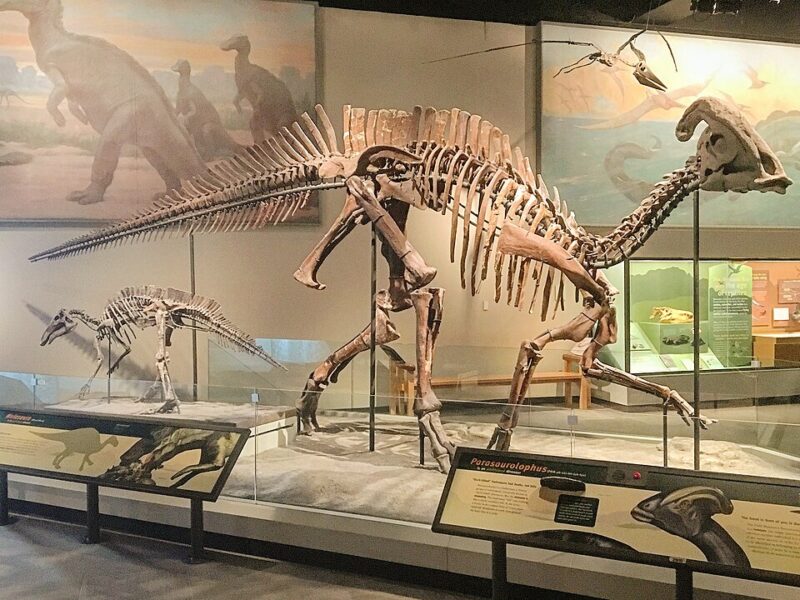




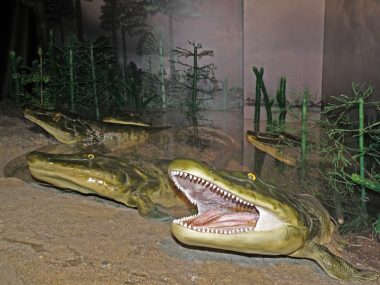
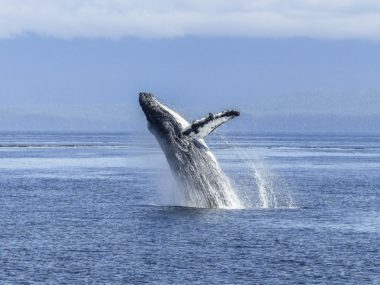




Good post. Another argument in favor of coexistence between dinosaurs and humans is the presence of radiocarbon in dinosaur (non-avian) fossils.
Thomas and Nelson began by predicting radiocarbon in dinosaur bones based on long-published reports of measurable radiocarbon in coal, diamonds, and other materials that evolutionary geologists assume are millions of years old. They gathered 16 samples of 14 fossil specimens of fish, wood, plants and animals from the entire geological column, from the Miocene to the Permian, from the three eras: Cenozoic, Mesozoic and Paleozoic. The samples came from various locations around the world, including Canada, Germany and Australia. About half were from dinosaur bones (7 specimens). All samples were prepared using standard processes to remove contamination and then sent to a laboratory for atomic mass spectrometry (AMS).
“Unexpectedly, all 16 samples submitted for measurement contained C-14. We found measurable amounts of 14 C in all 14 fossils of our and other dinosaurs. Additionally, we found surprising consistency in this data, ranging from approximately 17,850 to 49,470 years ago. radiocarbon.”
https://www.creationresearch.org/crsq-2015-volume-51-number-4_radioncarbon-in-dinosaur-and-other-fossils
A well researched article again. Yet this creationist suggests that there wwre no dinosaurs. instead they are misidentified creatures we have today. The kinds created on creation week were possible very few kinds. So after the falkl they morphed into creatures we call dinosaurs and others. however this spectrum of diversity would hide thier original prefall look. So at the flood they were fossilized in those bodyplans but on the ark a rebooting took place. Back to the original kind look or like that. after the flood AGAIN a spectrum of diversity exploded wity them. so the four legged so called sauropods are today just horses, camels, deer, or who knows what. tHis is why there are no horses etc etc found in the dino fossil areas. they did not exist on earth in those bodyplans. the theropod dinosaurs are clearly just floghtless ground birds.they all had wishbones like birds and feathers indeed. they were just birds. however big its just spectrums of diversity. The theropods should be the clue to thoughtful creationists. There were no dinosaurs. tHey were not lizards. there were none after the flood because they had changed bodyplans from the paors etc off the flood. there wwre few kinds created on creation week because animals are not that important. they wwre made for mans use and only a few needed.
Seems like you’re more an evolutionist than a creationist. You might benefit by reading the creation story in Genesis and the descriptions of Leviathan and Behemoth in Job. To compare Behemoth to a crocodile, as they author of this article suggests, is just ludicrous. The animals we observe today, as created by God, are what we see in the fossil record. There are known intermediaries, transitional, or new species, just variations within the same species. Even Megalodon was just a shark, as huge as it was. There is no basis in the Bible records to even suggest that animals morphed physically between the pre-flood and post-flood event.
Correction to my previous comment:
I stated, “There are known intermediaries…” should read as, “There are NO known intermediaries…”